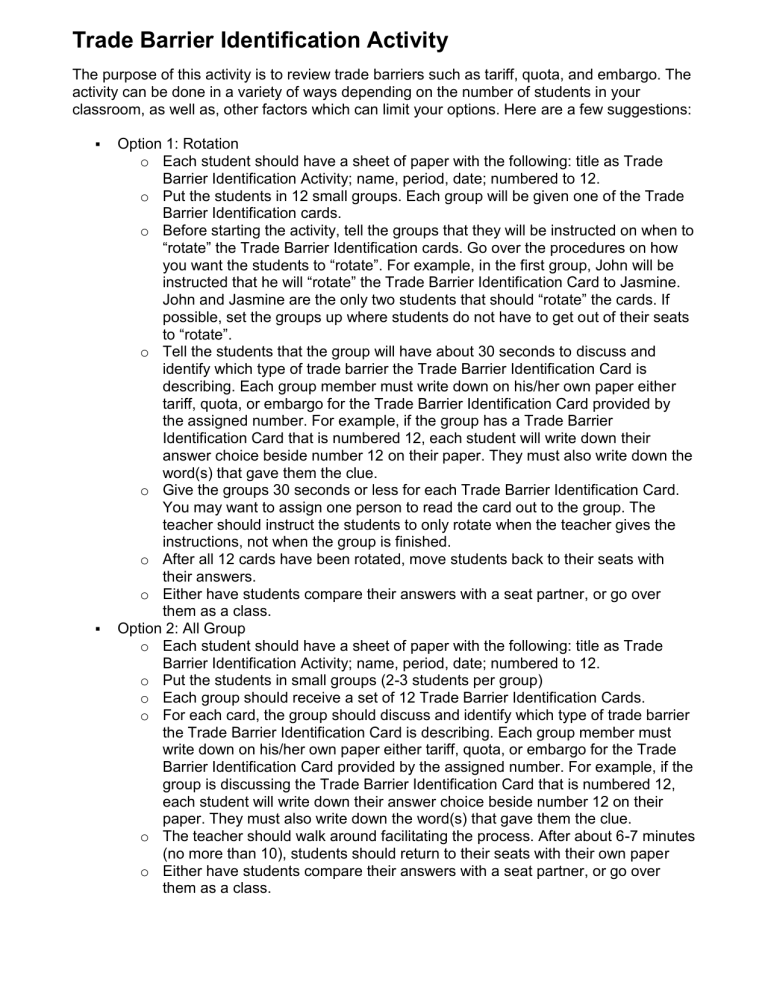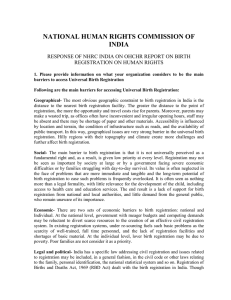
Trade Barrier Identification Activity The purpose of this activity is to review trade barriers such as tariff, quota, and embargo. The activity can be done in a variety of ways depending on the number of students in your classroom, as well as, other factors which can limit your options. Here are a few suggestions: Option 1: Rotation o Each student should have a sheet of paper with the following: title as Trade Barrier Identification Activity; name, period, date; numbered to 12. o Put the students in 12 small groups. Each group will be given one of the Trade Barrier Identification cards. o Before starting the activity, tell the groups that they will be instructed on when to “rotate” the Trade Barrier Identification cards. Go over the procedures on how you want the students to “rotate”. For example, in the first group, John will be instructed that he will “rotate” the Trade Barrier Identification Card to Jasmine. John and Jasmine are the only two students that should “rotate” the cards. If possible, set the groups up where students do not have to get out of their seats to “rotate”. o Tell the students that the group will have about 30 seconds to discuss and identify which type of trade barrier the Trade Barrier Identification Card is describing. Each group member must write down on his/her own paper either tariff, quota, or embargo for the Trade Barrier Identification Card provided by the assigned number. For example, if the group has a Trade Barrier Identification Card that is numbered 12, each student will write down their answer choice beside number 12 on their paper. They must also write down the word(s) that gave them the clue. o Give the groups 30 seconds or less for each Trade Barrier Identification Card. You may want to assign one person to read the card out to the group. The teacher should instruct the students to only rotate when the teacher gives the instructions, not when the group is finished. o After all 12 cards have been rotated, move students back to their seats with their answers. o Either have students compare their answers with a seat partner, or go over them as a class. Option 2: All Group o Each student should have a sheet of paper with the following: title as Trade Barrier Identification Activity; name, period, date; numbered to 12. o Put the students in small groups (2-3 students per group) o Each group should receive a set of 12 Trade Barrier Identification Cards. o For each card, the group should discuss and identify which type of trade barrier the Trade Barrier Identification Card is describing. Each group member must write down on his/her own paper either tariff, quota, or embargo for the Trade Barrier Identification Card provided by the assigned number. For example, if the group is discussing the Trade Barrier Identification Card that is numbered 12, each student will write down their answer choice beside number 12 on their paper. They must also write down the word(s) that gave them the clue. o The teacher should walk around facilitating the process. After about 6-7 minutes (no more than 10), students should return to their seats with their own paper o Either have students compare their answers with a seat partner, or go over them as a class. Trade Barrier Identification Activity Option 3: Individually o This option is the least suggested, but there may be some classes that have not mastered working in groups. You may want to try the activity in small groups and separate them as needed. Answers: 1. 2. 3. 4. 5. 6. 7. 8. 9. 10. 11. 12. Tariff, “tax” Quota, “limit” Embargo, “prohibited” Embargo, “restrict” Tariff, “tax” Quota, “limited” Tariff, “tax” Embargo, “restriction” Quota, “limit” Tariff, “tax” Quota, “limit” Embargo, “prohibits” Trade Barrier Identification Cards 1. Company XYZ produces cheese in Scotland and exports the cheese, which costs $100 per pound, to the United States. A 20% tax would require Company XYZ to pay the United States government $20 to export the cheese. 2. In 2010, Mexico imposed a limit of 250,000 tons of sugar that could be imported into Mexico. 3. In 1962, the United States prohibited all imports and exports to and from Cuba. 4. In 2006, the United Nations Security Council unanimously adopted a resolution to restrict the export to and the import from Iran on certain items and technology potentially related to nuclear weapons. 5. In 2010, China announced that it would impose and import a tax on American poultry of up 105.4 percent. 6. In 2005, the United States limited the imports of Chinese textiles to 7.5% a year. Trade Barrier Identification Cards 7. In 2012, the United States Commerce Department announced that it would impose a tax ranging from 2.9% to 4.7% on Chinese made solar panels. 8. In June of 2013, the European Union described to lift restrictions of the trade of weapons to Syrian rebels. 9. In 1990, the Japanese Government announced it would extend its voluntary limit on automobile exports to the United States. 10. Argentina increased taxes to 9% on the import of milk powder after record levels of imports and fears Argentina farmers would suffer falling incomes. 11. In 2011, the United States Department of Agriculture increased its annual sugar-import limit to 1.6 million tons for the year. 12. In 2006, the United Nations passed a Resolution that prohibits states from directly or indirectly supplying North Korea with conventional weapons (battle tanks, artillery, aircraft, missiles, etc.)



